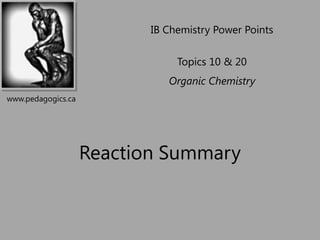
Topic 10 & 20 reaction summary and review
- 1. IB Chemistry Power Points Topics 10 & 20 Organic Chemistry www.pedagogics.ca Reaction Summary
- 2. Reactions and Mechanisms SL and HL
- 3. Conc OH-, ethanol, Δ (elimination) 1o or 2o R-X 3o R-X Homolytic fission, UV light (substitution) KCN SN1 H2, Ni catalyst, NaOH, Δ (substitution) Δ, pressure H2, Ni catalyst, Δ (addition) 3o R-X (reduction) SN2 1o R-X (addition) X2 or HX, Δ (condensation) with R-COOH (addition) H2O, [H2SO4], Δ polymerization addition (oxidation) H+,Cr2O72-, Δ reflux (condensation) with R-OH
- 5. Combustion reactions not included in this summary. You are still responsible for the stoichiometry of these reactions, problems using PV=nRT, and empirical formula – combustion analysis problems Only two mechanisms are required at SL - Homolytic fission - Nucleophilic substitution
- 6. Homolytic fission, UV light Alkane Reactions Making halogenoalkanes by process of homolytic fission. Know what a radical is Understand and memorize the the 3 steps – Initiation, Propagation and Termination This reaction REQUIRES light
- 7. Homolytic fission, UV light Alkene Addition Reactions With hydrogen gas to make H2, Ni catalyst, Δ (addition) alkanes
- 8. Homolytic fission, UV light Alkene Addition Reactions With hydrogen gas to make H2, Ni catalyst, Δ (addition) alkanes With halogens or HX’s to make halogenoalkanes (R-X) (addition) X2 or HX, Δ
- 9. Homolytic fission, UV light Alkene Addition Reactions With hydrogen gas to make H2, Ni catalyst, Δ (addition) alkanes With halogens or HX’s to make halogenoalkanes (R-X) (addition) X2 or HX, Δ With water to make alcohols (R-OH) (addition) H2O, [H2SO4], Δ
- 10. Homolytic fission, UV light Alkene Addition Reactions With hydrogen gas to make H2, Ni catalyst, Δ (addition) alkanes With halogens or HX’s to make halogenoalkanes (R-X) (addition) X2 or HX, Δ With water to make alcohols (R-OH) (addition) H2O, [H2SO4], Δ Monomer subunits combine to polymerization make polymers addition
- 11. Oxidation of Alcohols Be able to recognize 1o, 2o and 3o alcohols Oxidizing agent is usually potassium dichromate. As dichromate ions are reduced color changes from orange to green Reflux – heated mixture is 2o R-OH are oxidized to (oxidation) condensed and re-reacted ketones. 3o are resistant H+,Cr2O72-, Δ reflux to oxidation 1o R-OH are oxidized first to aldehydes and then to carboxylic acids
- 12. Nucleophilic Substitution NaOH, Δ (substitution) Be able to recognize 1o, 2o and 3o halogenoalkanes
- 13. Nucleophilic Substitution SN1 NaOH, Δ (substitution) 3o R-X 3o halogenoalkanes react with OH- to make alcohols by SN1 mechanism. (carbocation intermediate)
- 14. Nucleophilic Substitution NaOH, Δ (substitution) 1o halogenoalkanes react with OH- to make alcohols by SN2 mechanism. (transition state) SN2 1o R-X
- 15. Homolytic fission, UV light SN1 NaOH, Δ (substitution) H2, Ni catalyst, Δ (addition) 3o R-X SN2 1o R-X (addition) X2 or HX, Δ (addition) H2O, [H2SO4], Δ polymerization addition (oxidation) H+,Cr2O72-, Δ reflux
- 16. HL Pathways
- 17. Conc OH-, ethanol, Δ (elimination) 1o or 2o R-X 3o R-X Homolytic fission, UV light (substitution) KCN SN1 H2, Ni catalyst, NaOH, Δ (substitution) Δ, pressure H2, Ni catalyst, Δ (addition) 3o R-X (reduction) SN2 1o R-X (addition) X2 or HX, Δ (condensation) with R-COOH (addition) H2O, [H2SO4], Δ polymerization addition (oxidation) H+,Cr2O72-, Δ reflux (condensation) with R-OH
- 18. HL adds nucleophilic substitution reactions with cyanide ion acting as the nucleophile and (substitution) KCN SN1 3o R-X SN2 1o R-X
- 19. HL adds nucleophilic substitution reactions with cyanide ion acting as the nucleophile and with ammonia (substitution) KCN SN1 3o R-X SN2 1o R-X
- 20. Nitriles can be REDUCED to amines in different ways H2, Ni catalyst, Δ, pressure (reduction)
- 21. Conc OH-, ethanol, Δ (elimination) Elimination reaction mechanisms compete with substitution when halogenoalkanes react with some nucleophiles Product is an alkene Which mechanism is favored depends on the reaction conditions
- 22. Conc OH-, ethanol, Δ (elimination) 1o or 2o R-X 3o R-X Elimination reaction mechanisms compete with substitution when halogenoalkanes react with some nucleophiles Product is an alkene Which mechanism is favored depends on the reaction conditions
- 23. Condensation reactions include Esterification – where an ester and water are formed by the reaction between a carboxylic acid and an alcohol (condensation) with R-OH
- 24. Condensation reactions include – where an amide and water are formed by the reaction between a carboxylic acid and an amine (condensation) with R-COOH (condensation) with R-OH
- 25. Conc OH-, ethanol, Δ (elimination) 1o or 2o R-X 3o R-X Homolytic fission, UV light (substitution) KCN SN1 H2, Ni catalyst, NaOH, Δ (substitution) Δ, pressure H2, Ni catalyst, Δ (addition) 3o R-X (reduction) SN2 1o R-X (addition) X2 or HX, Δ (condensation) with R-COOH (addition) H2O, [H2SO4], Δ polymerization addition (oxidation) H+,Cr2O72-, Δ reflux (condensation) with R-OH
